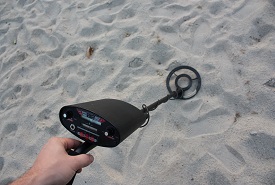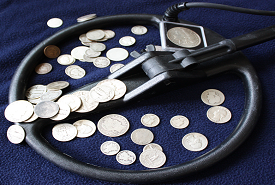Interested in beach metal detecting? Or have you been hunting the beach with little to show for it?
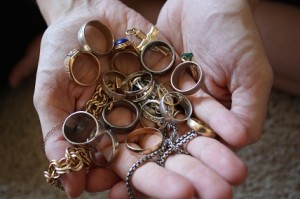 You have come to the right place! Here are some beach metal detecting tips I have uncovered in my time metal detecting both the dry sand and the wet/water. The picture to the right should get you excited about all the beach metal detecting finds that are possible! However, keep in mind, it is not all glitter and gold because metal detecting on the beach will produce a wide variety of junk as well. The beach metal detecting tips below should help you concentrate on the areas that are most likely to produce the goodies!
You have come to the right place! Here are some beach metal detecting tips I have uncovered in my time metal detecting both the dry sand and the wet/water. The picture to the right should get you excited about all the beach metal detecting finds that are possible! However, keep in mind, it is not all glitter and gold because metal detecting on the beach will produce a wide variety of junk as well. The beach metal detecting tips below should help you concentrate on the areas that are most likely to produce the goodies!
Using the Right Metal Detector For the Beach:
Keep in mind, for dry sand metal detecting, all the beginner metal detectors listed here will perform well and if you want more bells and whistles any of the relic machines discussed here will comb the dry sand with ease and provide great discrimination which is a must on trashy beaches. If the wet sand & water appeals to you, check out this page on the most popular underwater metal detectors.
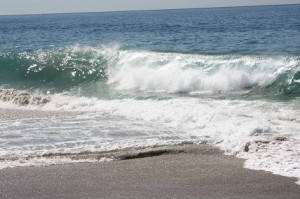 The first beach metal detecting tip is learning how to read the beach. I will get into details below but this is about developing an understanding of the beach you regularly hunt. Just like with relic hunting, research pays off. You have to think about all the variables. I am a creature of habit, I hunt the same two beaches regularly. Why? Because I know them like the back of my hand. I know when the sand levels are low/high. I know where people swim most of the time. I know when the clean up crew comes and I even know when most of the detectorists are there! Knowing this gives me an advantage because I am able to adjust how I detect to maximize my finds.
The first beach metal detecting tip is learning how to read the beach. I will get into details below but this is about developing an understanding of the beach you regularly hunt. Just like with relic hunting, research pays off. You have to think about all the variables. I am a creature of habit, I hunt the same two beaches regularly. Why? Because I know them like the back of my hand. I know when the sand levels are low/high. I know where people swim most of the time. I know when the clean up crew comes and I even know when most of the detectorists are there! Knowing this gives me an advantage because I am able to adjust how I detect to maximize my finds.
What Are the Beach Metal Detecting Dry Sand Hotspots?
I know the feeling when you get to the beach…where the heck do I start this place is huge. Yes it can be intimidating but you have to focus. You need to ask yourself these questions, have beach-goers been in the water lately or have they been just relaxing and catching some rays? Are there certain entry/exit points that many beach-goers go over? Are there “activity centers” like volleyball courts, horseshoes, or places where other sports are played? You need to focus on maximum potential for the beach. Don’t have answers to these questions? This is one of the most important beach metal detecting secrets, do research! Grab a towel and sunscreen and head for the beach when most people are there. See what they are doing. For example, in Southern California from January to April the sun is shining (weather permitting), it’s beautiful out but why are there so few in the water compared to laying out on the beach? Because the water is very cold! Before you North Eastern people call me a wuss, it’s all relative, we are warm blooded down here! Yes there will be some brave souls in the water but it will pale in comparison to those relaxing and enjoying the sun. Therefore, I focus on the dry sand hotspots like the “towel line”, volleyball courts, and fire pits discussed below. Now when the water gets warmer and the summer kicks in, I shift my focus to the wet sand.
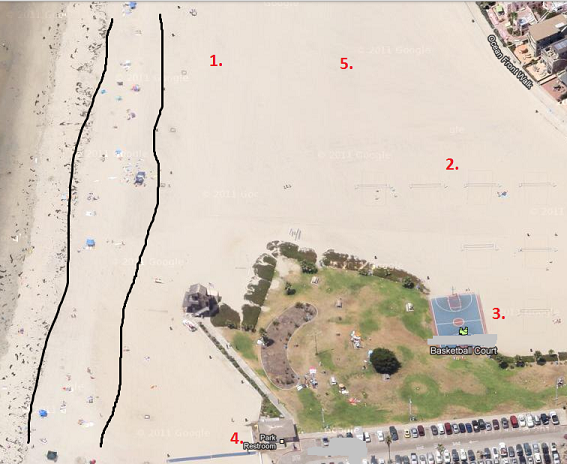 Dry Sand Hotspots:
Dry Sand Hotspots:
1. Towel line is the first place I check when metal detecting on the beach. This is where people place their towels and belongings and put on sunscreen. Sunscreen and/or sweat cause greasy fingers, increasing the likelihood of a ring falling off. I have found sunglasses, coin spills, rings, and necklaces in this area. Be prepared to dig plenty of trash but you will be rewarded. Those two black lines show the current “towel line” on this beach. Notice how they are all roughly the same distance from the wet sand. If you want to focus on this section, pick the highest concentration of people as with some beaches the towel line can extend pretty far. If you have not been to the beach before and you are unsure of where the towel line is look for sand build up before the wet sand, many people perch on these mounds. Also, you will get to know the different impressions in the sand that indicate different activities. Seeing where a towel was is pretty easy to determine, as well as foot traffic. Look for these signs and swing your detector to see if they left anything behind!
2 & 3. Activity centers such as the volleyball courts, horseshoes, or see where people like to play soccer, football, you name it. Also check beside them, this is where they place their belongings and spectators watch. Sports can rip necklaces and bracelets from their wearer. As you can see by the picture there are plenty of volleyball courts but there is also a paved basketball court. Most of the spectators will be watching in the grass and in the sand. Check these areas as well.
4. Entry/exit points are where people may stumble to grab last minute items or need to adjust just how they are holding things. For example at this beach, the restroom serves as the entrance/exit as well. Scan along the wall/walkway by that location as that is where people set their things when they are rinsing off. Also, anytime someone is jumping, in this case over the cement wall, the chances of something flying out of their pocket increases. Keep this in mind when you are scanning along the low walls that line the beach.
5. Wide open space is going to be the last place you should check. While it may produce a great target the odds are slim. As you can see by this picture the area is large and will take a long time to cover. If you have a large amount of time to search, you can give it a try. If I have hunted out all the normal hotspots I will usually hunt this quickly and randomly just to see if I get a target or two. If I am finding targets, I slow down and swing carefully.
Metal Detector Finds Pouch
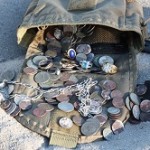 With all the goodies found at your favorite metal detecting beach you are going to need a place to put them so you can continue on your hunt. Metal detecting finds pouches are worn on the waist (most come with a belt) and are designed to hold not only trash items but your keepers in different compartments. Another important feature are “drain holes” so you can quickly rinse out all the sand that is stuck to your beach metal detecting finds, making clean up much easier.
With all the goodies found at your favorite metal detecting beach you are going to need a place to put them so you can continue on your hunt. Metal detecting finds pouches are worn on the waist (most come with a belt) and are designed to hold not only trash items but your keepers in different compartments. Another important feature are “drain holes” so you can quickly rinse out all the sand that is stuck to your beach metal detecting finds, making clean up much easier.
Unique landmarks can produce finds. When I say landmarks I mean anything that is unique to that beach where people would throw their stuff for the day. Examples would be under trees, by piers, or even sand dunes. People want to be able to easily remember where they put their belongings. Throwing their towel and backpack by the pier is easy to remember and they will be able to locate where their stuff is if they go in the water.
Life guard towers 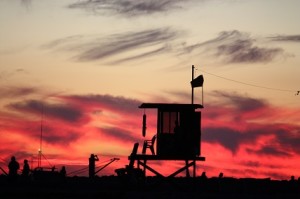 can be great as well. Beach-goers like to sit and relax on these when the lifeguards are off duty. You can find dropped goodies in the sand nearby. Also, people tend to congregate near life guard towers during the day and are more likely to go in the water in front of them for obvious reasons. Keep this in mind when you are doing your research on where people are on the beach. Remember life guard towers are usually made of aluminum or other metal. One idea is to wait and see if they move them after the summer is over, usually you can find a good assortment of coins and other items where they sat for the season.
can be great as well. Beach-goers like to sit and relax on these when the lifeguards are off duty. You can find dropped goodies in the sand nearby. Also, people tend to congregate near life guard towers during the day and are more likely to go in the water in front of them for obvious reasons. Keep this in mind when you are doing your research on where people are on the beach. Remember life guard towers are usually made of aluminum or other metal. One idea is to wait and see if they move them after the summer is over, usually you can find a good assortment of coins and other items where they sat for the season.
Fire pits 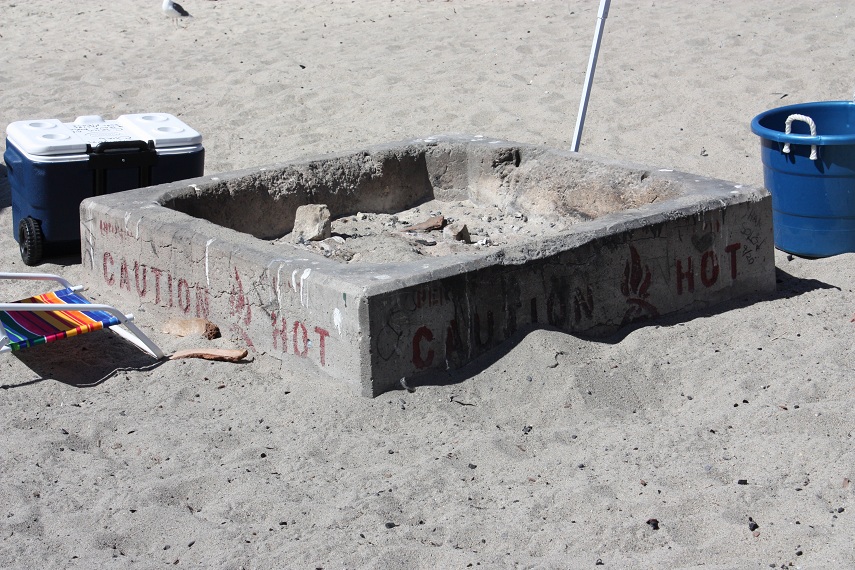 can produce great finds but you will also dig nails, aluminum blobs, and food wrappers. You may need to turn up the discrimination. I recommend that you have some experience with your beach metal detector before you try metal detecting around fire pits as it can get frustrating digging all that trash. You should consider getting a sniper coil
can produce great finds but you will also dig nails, aluminum blobs, and food wrappers. You may need to turn up the discrimination. I recommend that you have some experience with your beach metal detector before you try metal detecting around fire pits as it can get frustrating digging all that trash. You should consider getting a sniper coil. These are small coils designed for trashy areas (parks, picnic areas, fire pits, etc). They also allow you to get closer to larger metal objects while still being able to hear the small targets close by. This is important for fire pits because some are concrete with rebar housing, causing most detectors to have problems when swinging your detector near them.
Secret/Private locations can be a gold mine.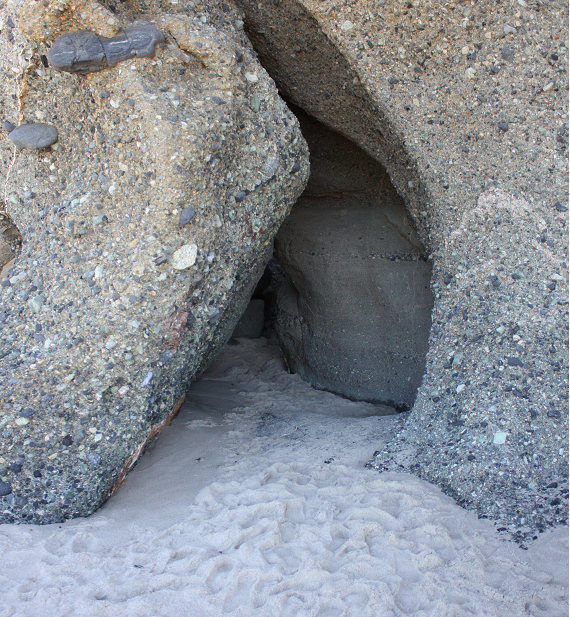 This one may seem strange but on many beaches you can walk in either direction and get to the less crowded parts of the beach where expensive homes line the sand. There can also be little nooks and caves that are scattered. This is make out central! Don’t go cruising around there at night or you may get a surprise. Also, people like to place their belongings in here to keep them protected from the elements. Please exercise caution when entering sea caves, some can be unstable. You can usually tell if there is people activity based on the prints left in the sand. If you see a lot of foot traffic, swing over the area, you may get lucky! I usually hit these during the day or in the early morning and these places have rewarded me with watches, jewelry, and coin spills.
This one may seem strange but on many beaches you can walk in either direction and get to the less crowded parts of the beach where expensive homes line the sand. There can also be little nooks and caves that are scattered. This is make out central! Don’t go cruising around there at night or you may get a surprise. Also, people like to place their belongings in here to keep them protected from the elements. Please exercise caution when entering sea caves, some can be unstable. You can usually tell if there is people activity based on the prints left in the sand. If you see a lot of foot traffic, swing over the area, you may get lucky! I usually hit these during the day or in the early morning and these places have rewarded me with watches, jewelry, and coin spills.
Final Dry Sand Beach Metal Detecting Tip: Timing!
Hunting the dry sand of a popular beach is extremely competitive and can be a vast stretch of land. The dry sand hotspots above should help you focus on WHERE to hunt but I also wanted to mention another of my beach metal detecting secrets: WHEN you should hunt the dry sand. If you are interested in metal detecting the dry sand, timing is important. My advice is to head down just before sun down on a Saturday or Sunday night. Why? Because the regulars like to head out the next morning but you will beat them to it! Now keep in mind, some beaches have curfews and if you are worried about people at night, try hunting from 6 p.m. to about 10 p.m. That way, its not terribly late and there will be some people around but there will be plenty of sand to hunt.
Wet Sand/Water Beach Metal Detecting Tips:
Many books have been written on where to hunt the wet sand/water. Why? Because its complicated! There are so many factors at play when searching the wet sand. Tidal movements, storms, shape of the beach, you name it. It comes down to one thing, sand movement. Below are some basics but if you really want to get in depth information check out this book which details wet sand hunting, Gold Beneath the Waves: Treasure Hunting the Surf and Sand.
How to find the ideal beach conditions: Knowing when to search the low tide/water is about researching the tides and the current wave conditions. I like to use www.magicseaweed.com because it gives both tide and wave details once you select your beach. Also, check to see if the beach you are metal detecting has a beach camera. These beach cameras are invaluable as they show how crowded the beach is, if there is a storm, current sand conditions, you name it.
Metal Detecting Low Tide:
I like to get to the beach in the morning around an hour before low tide. Some like to get there earlier but I have a day job and waking up around 5 a.m. is hard enough. I prefer to work the visible wet sand, starting where most of the water activity takes place. Depending on how much sand is on the beach you want to focus on flat portions. If there is a slope and then it levels out, work that area. Items can be pushed onto the slope but for the most part they will settle in the leveled out area. Look for jetties or the ends of beaches as sand can accumulate here, as well as targets.
Look and feel the sand: What is the consistancy, when you press your foot in does it sink in a little or is there resistance. This is important because this will determine how deep the targets are and how much light sand is covering them up. You want to feel hard packed sand. If you see shells or rocks, this is a good sign. It shows that there is potential for metallic targets as well. Also, some beaches have overburden sand and beneath a rock/shell/clay layer of sand. The closer you are to this layer the better, as most objects get stuck in this mixture as it is very dense.
The first hotspot to look for are “troughs”. These are areas close to water line that have created a long trench running parallel along the beach, they are usually in the water or can be visible during a negative tide. Items will settle in the trough, I usually find the heavier items here, like watches, old phones, etc.
Another hotspot are “scallops“. These are similar to troughs but instead of being in the water, they form during the transition between high tide and low tide. They are different in that they run perpendicular to the beach. It will look like the beach has humps as there will be high and low sections. The low sections act to funnel wave action whereas the higher banks have little sand movement. Items will settle in certain locations typically on the banks or if there is a slope, when the slope starts to decrease. Remember the wet area is lower, so you may be able to find deeper, older items in that area depending on how deep the scallop is.
These are similar to troughs but instead of being in the water, they form during the transition between high tide and low tide. They are different in that they run perpendicular to the beach. It will look like the beach has humps as there will be high and low sections. The low sections act to funnel wave action whereas the higher banks have little sand movement. Items will settle in certain locations typically on the banks or if there is a slope, when the slope starts to decrease. Remember the wet area is lower, so you may be able to find deeper, older items in that area depending on how deep the scallop is.
One thing to keep in mind is that as you search the wet sand of the beach you may find a concentration of items. This is called a “pocket“. You want to really go slow in this area because if you are finding concentrated items like crusty coins or heavier items, the likelihood of old jewelry in going to be increased.
Beach Metal Detecting: Water Hunting
This is the final step in beach metal detecting because it is by far the most difficult. There are guys out there who dive and go past their necks when metal detecting which I do not do, nor do I have any experience. For the purposes of water hunting I am talking about around knee to chest high. Any higher and you need to worry about weight belts and other gear. Remember you may be able to detect out in the deep water but good luck digging up a target.
Finding Targets: Similar to wet sand hunting, looking for troughs is key. Also, look for shells or any debris that is on the bottom. Those items collect in certain areas underwater, usually just past the wave break. Work slowly because the increased friction on the coil and shaft from the water can tire you out quickly and puts additional strain on the shaft. Keep your eye on waves as a surprise one can ruin your day. Also, shuffle your feet so you don’t get a nasty surprise from a stingray.
Digging Targets: Now the fun begins. Extracting the target without it being washed away! Once you have a good target place the coil over the target on the ground and hold it there as best you can. Get your feet in a solid spot so you have a good sturdy position. Place your beach scoop right below the coil. Wait for a break in the wave activity, preferably right after one has past you, then start digging, hopefully you will get it in the first scoop. Be especially careful for waves and be sure you take decent sized scoops as there is a chance the target can get swept away from the waves.
If you are a serious water/wet sand hunter than the tides will be a primary guide for when you hunt. I usually check online but when I am at the beach I like to know where the tide is at. I got my tide watch as a gift. I put mine on when I plan to go hunting so I know how much time I have left with a low tide. The Casio Tide Watch I have is inexpensive and has held up pretty well. You would be surprised how fast the time flies when you are metal detecting!
Beach Metal Detecting Scoops:
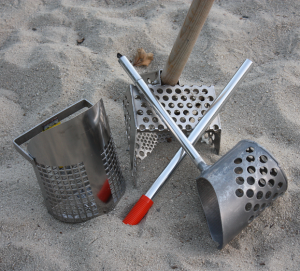 A durable, metal detecting sand scoop is probably the second most important item to have right behind the metal detector itself. Why? How else are you going to get the targets in the sand or even the water. Metal detecting sand scoops come in different materials and different sizes depending on your budget. Some are great for the dry sands of the beach while others are heavier but designed to cut through the thickest wet sand. Have a look at my page dedicated to metal detecting sand scoops.
A durable, metal detecting sand scoop is probably the second most important item to have right behind the metal detector itself. Why? How else are you going to get the targets in the sand or even the water. Metal detecting sand scoops come in different materials and different sizes depending on your budget. Some are great for the dry sands of the beach while others are heavier but designed to cut through the thickest wet sand. Have a look at my page dedicated to metal detecting sand scoops.
General Beach Metal Detector Tip: How to Keep Track of Your Finds!
Knowing the details of where/when you found something memorable is a great tool for finding the same items in the future. What I mean is, you need to keep a “metal detecting finds log”. I use Microsoft Excel, but you can use a pad and paper. I usually start with the date, the name of the beach and go on from there. Here is an example:
05.13.2013 Newport Beach. Night time, Low Tide. Sand Level High. Found few targets in the dry sand but many in the wet sand near the pier. Found a gold ring at the high tide line.
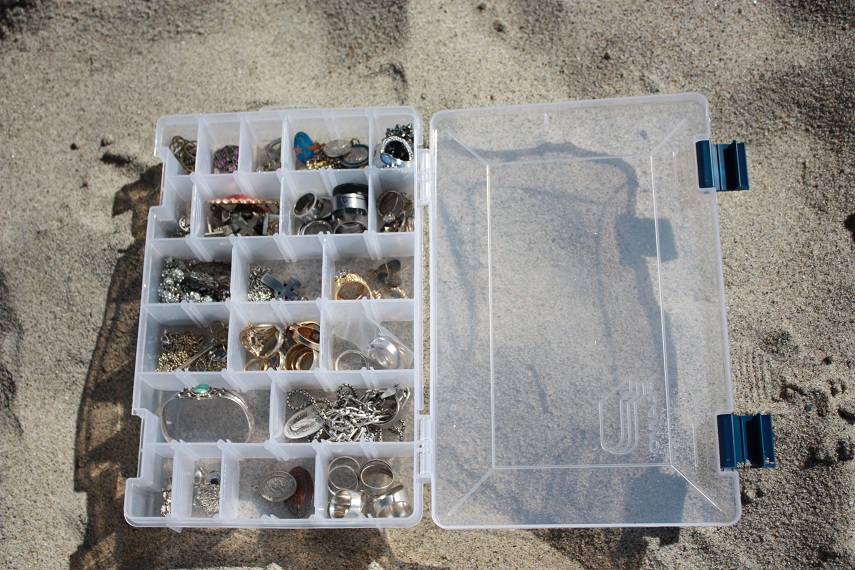 As you can see, this doesn’t have to be super detailed but provides important factors and how much I found that day. You can even log how much change you found etc. I then like to compile all the hunts for the year and see where/when I found the most items. Did I find more at night or in the morning? Dry sand versus wet sand? etc. Having this information, you can fine tune where you hunt and at what time to maximize your finds.
As you can see, this doesn’t have to be super detailed but provides important factors and how much I found that day. You can even log how much change you found etc. I then like to compile all the hunts for the year and see where/when I found the most items. Did I find more at night or in the morning? Dry sand versus wet sand? etc. Having this information, you can fine tune where you hunt and at what time to maximize your finds.
The finds log is great for keeping track of the beach conditions but where should you keep the actual items you find? I use these Plano stowaway containers with adjustable dividers. They are under $5 bucks and simple to set up because you can move the dividers with ease. For example, in the picture, these are my jewelry finds seperated by type and what they are made out of.
